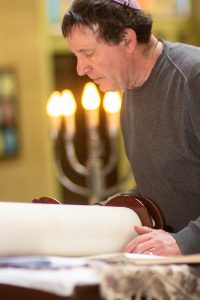Simon Says, January 17, 2020
Thought Provoking Insights by Rabbi Simon Rosenbach
 We are starting a new Book of the Torah this week, the Book of Shmot. The Book of Shmot has as its central theme of the Exodus from Egypt (hence the English name [actually Greek] Exodus), and the Exodus from Egypt is embedded in every Jewish fiber of our lives. When we make Kiddush on Friday night, we say, “Zecher litzi-at mitzrayim (remember the Exodus from Egypt).” Traditional Jews who pray three times a day recite the Song at the Sea (Az Yashir) daily. The psalms are replete with Exodus references. Given that the Exodus and the Revelation at Sinai are the two biggest events in the history of our people, why is the Book named Shmot (names)?
We are starting a new Book of the Torah this week, the Book of Shmot. The Book of Shmot has as its central theme of the Exodus from Egypt (hence the English name [actually Greek] Exodus), and the Exodus from Egypt is embedded in every Jewish fiber of our lives. When we make Kiddush on Friday night, we say, “Zecher litzi-at mitzrayim (remember the Exodus from Egypt).” Traditional Jews who pray three times a day recite the Song at the Sea (Az Yashir) daily. The psalms are replete with Exodus references. Given that the Exodus and the Revelation at Sinai are the two biggest events in the history of our people, why is the Book named Shmot (names)?
I know what are you going to answer: the Books of the Torah take their names from the first substantive word (the Book of Shmot actually starts, “v-eleh shmot [and these are the names]”), but that doesn’t answer the question. The editors of the Torah could have, for example, put the first few chapters of Shmot into Bereshit. The editors of the Torah could have, for example, started with the Exodus and told the story of the enslavement of the Israelites in flashback. The editors of the Torah could have, started with the Revelation at Sinai and have God told the story of the enslavement and the Exodus as a kind of preface to the Revelation. But the editors of the Torah did not do any of these things. The editors of the Torah began the Book of Shmot with, v-eleh shmot, these are the names.
I am not the smartest person in the world, but I think that editors of the Torah began the Book of Shmot with a list of names on purpose. For starters, the list of the sons of Jacob promotes continuity. As I have explained, however, the Book of Bereshit didn’t need to end where it ends; the first chapter or two in the Book of Shmot could belong to Bereshit. More importantly, to my mind, the list of names that begins the Book of Shmot puts a human face on a Book that is primarily concerned with God’s miracles.
Descendants of Jacob’s sons (ourselves included) might have felt (and might feel) insignificant in the shadow of these miracles. The miracles saved a people, and another set of miracles gave a people the Torah, and it is easy to feel like you are a speck of dust in the vast, infinite universe. But the miracles didn’t only save a people, the miracles saved people, and they had names and identities. And the miracles didn’t only give the Torah to a people, the miracles gave the Torah to people, and they had names and identities. And so, descendants of Jacob’s sons (ourselves included), can read the Book of Shmot and feel as though they have a connection with the names of Jacob’s children that begin the Book of Shmot. Individuals left Egypt, and individual received the Torah, and we are among the individuals. That is why the Book is called Shmot.